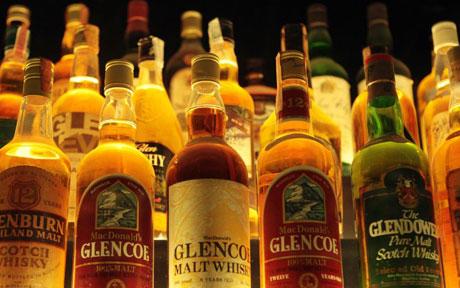Whiskies
While countries in Southern Europe made wine, countries in Northern climates like Scotland and Ireland made whisky. Due to the fact grapes did not grow well in these regions, the alternative was grains.
Whisky comes from the word uisgebeatha in Scotland and uisgebaugh in Ireland, a Celtic translation of aqua vitae.
Whisky can be broken down into many different classes. Depending on where and how its created makes all the difference.
- Scotch
- Irish Whiskey
- Bourbon
- Rye
- Blended American
- Light whisky
- Canadian
- Single Malt Whisky
To make whisky, one needs to get the grain to ferment, but to start, the starch of the grain must be converted to sugar. This is done by adding Malt, a sprouted grain, usually barley.
Then, malt, grain and hot water are mixed together until conversion takes place. The liquid then ferments when yeast is added.
From there, the raw whiskey is then stored in barrels, usually made of oak for at least 2 years. It doesn't stop there fine whisky can be aged for decades to achive optimal taste and flavour. What ever you fancy there is a type of whisky out there for your taste buds. After a long day at the office its hard to beat a Whisky on the rocks to unwind ;)

 Single Malt Whisky is a whisky made from only one type of malted grain and distilled at one particular distillery. Single malts are traditionally made from barley cultivated near the distillery concerned, although there are some single malt rye whiskies. Most single malt whiskies are distilled using a pot still. Single malts are typically associated with Scotland, though they are produced elsewhere, notably in Ireland and Japan. All single malt goes through a similar batch production process, as outlined below. At bottling time various batches are mixed together or vatted to achieve consistent flavors from one bottling run to the next. Some variation does occur.
Single Malt Whisky is a whisky made from only one type of malted grain and distilled at one particular distillery. Single malts are traditionally made from barley cultivated near the distillery concerned, although there are some single malt rye whiskies. Most single malt whiskies are distilled using a pot still. Single malts are typically associated with Scotland, though they are produced elsewhere, notably in Ireland and Japan. All single malt goes through a similar batch production process, as outlined below. At bottling time various batches are mixed together or vatted to achieve consistent flavors from one bottling run to the next. Some variation does occur.

